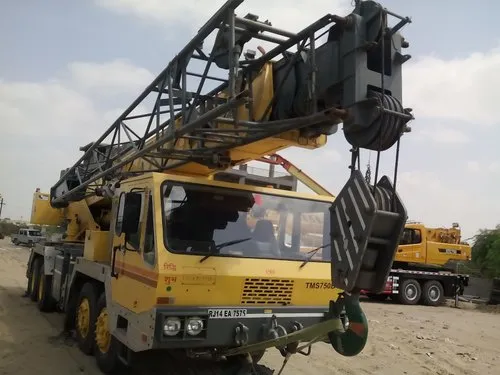Streamlining Inventory Management: The Key to Cost-Efficiency in Crane Rentals
The increasing infrastructure projects across all over the globe are causing the expansion of the rental of cranes. Government initiatives that are favorable to the industry are helping to boost the growth of this industry.
The management of inventory is essential for companies that rent cranes. Incorrectly managed inventory caused by ineffective tracking can be costly. In order to avoid this the possibility of this happening, you should think about using software that has advanced analytics to help you keep track of the utilization rate of your cranes.
Telematics and IoT Integration
The market for crane rentals worldwide is driven by the increase in building activities as a result of the urbanization process. Government initiatives that are favorable and investment in infrastructure for commercial use are propelling the market forward.
The technological advancements that have taken place in the field of telematics allow crane operators to monitor more details about their machines. Although GPS monitoring has been an effective tool, the newer emergence of low-cost IoT cell connectivity as well as cloud-based architectures that are simple to incorporate have provided an entirely new platform to monitor machine performance.

A telematics solution integrated can monitor a range of information points, such as the way a crane is used and rented. Software solutions such as DynaRent will provide the information you need through extensive reports, which allow you to monitor trends in rental and provide more precise budgeting decisions. Additionally, the time journal feature of DynaRent allows you to charge for hours when the equipment isn’t being utilized. This helps to prevent overuse and allows you to increase your earnings potential.
Remote Operation Technology
In contrast to pendants with wires, wireless remote radio control don’t contain transmission lines that could become entangled with equipment or edges of building. The crane is therefore safer to operate. Also, it eliminates the requirement to hire additional spotters or relay workers, which decreases the cost of labor.
But, the implementation of this method could be a challenge for many businesses due to the lack of knowledge in technology and the time limitations. It is possible to overcome these obstacles with software that can share availability of equipment at a real-time pace, assisting with the scheduling process and allocation.
The hour journal feature of DynaRent allows users to record the exact hours of work and bill customers accordingly, thus preventing excessive utilization and loss of revenue. Additionally, it is able to handle complicated contracts easily and eliminate all revenue recognition problems. Additionally, it helps keep on top of the condition of cranes and ensure that the required checks have been carried out. This helps reduce downtime, and also ensures your safety and security of employees.
Advanced Safety Systems
In the quest for greater precision and more effective safety measures is constantly evolving the design of cranes has been redesigned to incorporate more safety methods to avoid collisions and accident. Systems to avoid collisions, such as those offered by the Magnetek company Intelli-Protect Systems, allow you to create “no-fly zones” that automatically reduce or stop the movement of cranes when they’re close to a barrier.
The warning systems are included in a range of motion control devices, such as Variable frequency drives (VFDs) as well as radio remotes. They are also able to be programed to work with limits switches, sensors, and many more.
Another method to increase crane safety is by the utilization of a collision control system that helps to manage interactions between tower cranes at the job site. The feature lets operators be in contact and work effectively with other workers in the same part on a construction site. This helps to prevent overloading and even damage to supports and runway beams that are caused by collisions with cranes.
Crane Rental Customization
A growing demand for construction projects that require special cranes is a major factor behind the development of the crane rental business. This includes the creation of intelligent cities transport and commercial infrastructure as well as energy and other. It has resulted in an increase in rental of equipment among different construction and development companies who would rather rent cranes instead of purchasing cranes.
Due to the increased demand for cranes, companies that rent them must find methods to increase profits and reduce maintenance costs. It is possible to do this through the accurate tracking of the inventory as well as assets. In particular, DynaRent helps to record project and job costs to make sure the quality of service will be reflected in the final invoice. DynaRent can also be utilized to plan tasks and the highly skilled technicians, drivers or crane operators will get work requests on their smartphones to record the hours worked and provide a high-quality service and look here now https://samcocranes.com/dich-vu/cau-25-tan/.
Through these advancements the crane rental businesses can enhance the effectiveness of their business operations as well as increase the level of satisfaction with their customers. By being able to monitor every aspect of their business from quotations to deconstruction, they are able to focus on the core areas of their business and grow within the industry of crane rental.
Eco-Friendly Taxis for the Environmentally Conscious
In an era where environmental concerns have taken center stage, the emergence of eco-friendly taxis has become a beacon of hope for the environmentally conscious traveler. These green alternatives to traditional taxis represent a significant stride toward reducing the carbon footprint of transportation services and mitigating the adverse effects of urban pollution. Eco-friendly taxis are more than just a trendy concept; they are a practical solution to address the growing climate crisis. One of the most prominent features of eco-friendly taxis is their reduced emissions. By harnessing innovative technologies such as electric and hybrid powertrains, these vehicles produce substantially fewer harmful emissions compared to their gasoline or diesel counterparts. Electric taxis, in particular, have gained immense popularity for their silent operation and zero tailpipe emissions, making them an ideal choice for congested city centers where air quality is a pressing concern. These taxis not only improve air quality but also contribute to the reduction of noise pollution, creating a more pleasant and livable urban environment for all.

Furthermore, the integration of eco-friendly taxis into urban transportation networks supports a shift towards sustainable mobility. These vehicles often incorporate advanced features like regenerative braking, which captures energy during braking to recharge the battery, thus increasing energy efficiency. This translates to lower operating costs for taxi drivers and, ultimately, more affordable fares for passengers. Additionally, some eco-friendly taxi services employ ride-sharing and pooling systems, reducing the number of vehicles on the road and further decreasing emissions while offering a more economical option for riders. The introduction of eco-friendly taxis has also sparked innovation in the taxi industry. With the adoption of cutting-edge technology, passengers can now book eco-friendly rides through smartphone apps, enabling them to choose environmentally responsible transportation at their convenience. Moreover, some eco-friendly taxi services offer in-car amenities such as Wi-Fi and phone charging stations, enhancing the overall passenger experience and setting a new standard for urban transportation services.
Beyond the immediate benefits to passengers and the environment, eco-friendly taxis provide economic opportunities for taxi operators and drivers taxi sân bay. Governments around the world are increasingly offering incentives and subsidies to encourage the adoption of green vehicles in the taxi industry. This not only promotes the growth of eco-friendly taxi fleets but also supports local economies by creating jobs in manufacturing, maintenance, and charging infrastructure development. In conclusion, eco-friendly taxis represent a crucial step toward a more sustainable and environmentally responsible future. They offer a cleaner, quieter, and more efficient mode of transportation for urban dwellers while reducing the negative impacts of traditional taxis on air and noise quality. As cities continue to grapple with the challenges of congestion and pollution, the adoption of eco-friendly taxis offers a tangible solution that aligns with the values of the environmentally conscious traveler and contributes to the global effort to combat climate change.
Offshore Empowerment – Hiding Money in Tax-Free Bliss
In the realm of global finance, the term offshore empowerment has become synonymous with a strategic yet controversial approach to managing financial assets. At its core, offshore empowerment refers to the utilization of international financial structures and jurisdictions to optimize taxation and protect wealth. The allure of tax-free bliss, as it is often coined, draws individuals and corporations seeking to maximize their financial resources by capitalizing on jurisdictions with favorable tax laws and regulations. One of the primary motivations behind offshore empowerment is the desire to minimize tax liabilities legally. Countries with low or zero tax rates on certain types of income have become magnets for those looking to preserve their wealth. By establishing financial entities or trusts in these jurisdictions, individuals can legally shield their assets from the burdensome taxes imposed in their home countries. Critics argue that such practices contribute to a global tax evasion problem, creating loopholes that enable the wealthy to accumulate vast fortunes while evading their fair share of contributions to public services.
Offshore empowerment is often associated with secrecy, as many jurisdictions offer strict financial privacy laws. While financial privacy is a legitimate concern for some individuals, the lack of transparency in offshore financial dealings has raised eyebrows among regulators and policymakers. The veil of secrecy surrounding these offshore accounts has, in some cases, facilitated illicit activities such as money laundering and corruption. The Panama Papers scandal, which exposed a vast network of offshore entities used by politicians, celebrities and business leaders to conceal their wealth, underscored the potential misuse of such financial structures. Governments around the world are increasingly cracking down on offshore empowerment, seeking to close loopholes and ensure that individuals and corporations pay their fair share of taxes.

International organizations, such as the Organization for Economic Co-operation and Development (OECD), have been working to establish global standards for tax transparency and exchange of information. The Common Reporting Standard (CRS), developed by the OECD, requires financial institutions to automatically exchange information about account holders with tax authorities, reducing the ability to hide assets offshore. In conclusion, while offshore empowerment may offer legitimate financial advantages, its association with tax avoidance, financial secrecy and potential misuse raises ethical and legal concerns. As governments strive to create a fair and transparent global financial system, the future of offshore empowerment remains uncertain. Striking a balance between legitimate tax planning and preventing illicit financial activities will be crucial in shaping the evolving landscape of international finance.